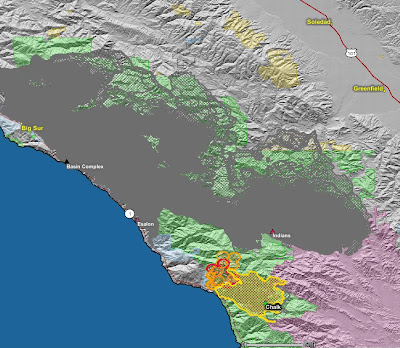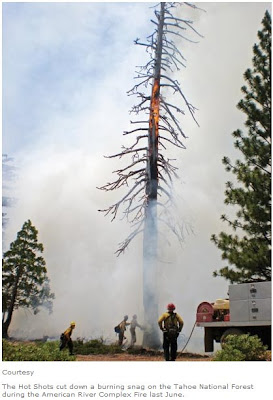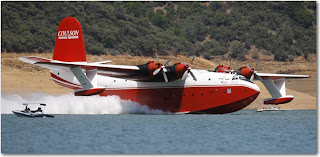Update @ 3:00 p.m. PT, Friday
Evacuation orders and warnings have been issued for some areas near the fire. InciWeb has more information.
==============================
The Chalk fire on the Los Padres National Forest has been burning since September 27. It is, again, in the greater Big Sur area, south of this summer's Basin Complex and the Indians fire.
Until five days ago it was managed by a Type 2 Incident Management Team, when it was turned over to a Type 3 IMTeam. For the last couple of days the fire has come back to life, burning thousands of additional acres. There are reports that 10 air tankers were assigned to the fire yesterday, which was last reported then on InciWeb as being 11,760 acres and 94% contained. Judging from the satellite map below, showing heat detected by satellites last night, that containment percentage will plummet.
The gray areas on the map are the other fires from this summer, the Basin Complex and the Indian fire, which burned together. Click on the map to see a larger version.

Today they are re-mobing, ordering the Type 2 IMTeam back to the fire.
HERE is a link to a web cam at the Nepenthe restaurant in Big Sur. Occasionally you can see smoke from the fire.
Big Sur Kate has been following the fire and has interesting commentary and photos--like she did during the other fires there this summer.
Downed power line started California's Sesnon fire
The Sesnon fire has burned 14,000 acres in Los Angeles County and is now 70% contained. Investigators determined it started from a power line. From the LA Times:
The power line believed to have sparked the Sesnon fire was not covered by strict state inspection and brush clearance rules because it was owned by a private utility on private land, according to regulators.
The California Public Utilities Commission confirmed Thursday that the electrical distribution line is owned by the Southern California Gas Co. and fell onto the utility's property. Commission rules require power lines owned by electric utilities to be inspected regularly and to have brush under the lines cleared to prevent fires. But commission spokesman Tom Hall told The Times that the rules don't extend to nonelectric utilities on private land.
"This line does not fall under PUC jurisdiction," Hall said. "But we do have a PUC inspector working with [the Gas Co.] to determine the cause."
Heavy winds blew down the distribution line in a remote unincorporated area of L.A. County north of Porter Ranch, fire officials said, sparking a huge blaze that destroyed 15 homes and damaged six, destroyed 47 outbuildings and may have contributed to the death of a motorist driving on the 118 Freeway.
"It's between the PUC and electric utility companies. We're not even looking at that," said Steve Dunn, senior civil engineer with the county Department of Public Works' utility section. "It's my understanding there's a maintenance program that's developed by electric utility companies in compliance with the CPUC."
It remains unclear whether the power line that fell had been inspected or whether the brush below had been cleared. A spokesman for the Southern California Gas Co. said only that the utility was fully cooperating with the investigation but declined to answer more detailed questions.
L.A. County Fire Deputy Chief Scott Poster, whose agency oversees brush clearance in unincorporated areas, said there are no county regulations specifically requiring brush clearance under electrical lines on private property unless the lines are near a structure.
There has been growing concern about the danger posed by power lines during the fire-prone Santa Ana winds season. Power lines were the suspected culprit behind at least five of the fires that burned across Southern California last October, including one in San Diego that consumed 200,000 acres, destroyed 1,041 homes and killed two people.
But placing lines underground is highly expensive -- with some cost estimates as high as $1 million a mile.
The utilities commission investigated last year's Witch fire in San Diego and concluded in a report released last month that San Diego Gas & Electric Co. failed to properly maintain power lines that were felled by the wind (the utility strongly disputed the finding).
Prescott, AZ: first city with Hot Shot Crew
Congratulations to the Granite Mountain Hot Shots for obtaining Type 1 Crew status.
 From the Daily Courier:
From the Daily Courier:PRESCOTT - When the Prescott Fire Department's Granite Mountain wildland firefighting crew members found out that they had become the first municipal Hotshot crew in the nation, they took a moment to tear the little "t" off their rig and then immediately set off on a rugged hike to the fire line in the heart of California's Klamath National Forest.
That "t" stood for "trainee," a label they had worn for two years while working hard to earn the elite title of Type I Interagency Hotshot Crew.
This season alone, they responded to 13 wildfires in four states while also helping Prescott residents create wildfire-defensible space on 95 acres around 12 homes. And they spent 2,000 hours in the classroom.
By the time they heard the big news last month via a call from the home department, they had been training for five years and waiting 3.5 months to hear whether the federal government had approved their request for certification.
Granite Mountain Hotshots Superintendent Eric Marsh was getting worried that much of his crew would disband for the season before the news arrived. Eight of the 20 members have year-round jobs.
Soon the news spread, and it felt great when other Hotshot crews that had supported their efforts told them they deserved the title.
His crew's motto comes from his college motto: Esse Quam Verdi (To Be, Rather Than To Seem).
The concept of a well-trained Hotshot crew originated with the U.S. Forest Service in California in 1947, and today 85 crews are certified. Only four are based outside of the federal government, and the other three are state or county based.
It is only appropriate for Prescott to join the Hotshot ranks, since it is the oldest city fire department in Arizona - established in 1885. The city also was the first in Arizona to adopt a wildland-urban interface building code that requires wildfire-defensible construction on homes.
Contract with Carson Helicopters suspended
From the Ventura County Star:
GRANTS PASS, Ore. — The helicopter company involved in a crash that killed nine people fighting a California wildfire said Thursday the suspension of its firefighting contract by the U.S. Forest Service is about the weight of one of its aircraft and not about safety.
"All our aircraft are FAA compliant and airworthy," Andy Mills, director of helicopter operations for Merlin-based Carson Helicopters, said. "This is not a safety issue. It's a contract issue."
Mills said the issue was the weight of one of the 10 helicopters Carson provides under contract with the Forest Service for fighting wildfires and may be because of the calibration of the scales used to weight it. Weighing more than is specified by the contract could affect a helicopter's lifting ability, and the Forest Service has the right to suspend the contract until the discrepancy is resolved, he said.
Seven firefighters for Grayback Forestry, a pilot for Carson and a U.S. Forest Service inspection pilot died Aug. 5 when their Sikorsky S-61N helicopter crashed on takeoff. It was ferrying the crew members from fire lines in the Shasta-Trinity National Forest.
The cause of the crash remains under investigation by the National Transportation Safety Board.
The Medford Mail Tribune reported the suspension followed a determination that the firm's 10 helicopters contracted to the agency did not meet contract requirements.
Susan Prentiss, branch chief for incident support contracting at the National Interagency Fire Center in Boise, Idaho, cited "a discrepancy in the weight," but would not elaborate. Prentiss said the suspension is not linked to the fatal crash.
Most of the 10 helicopters contracted to the Forest Service returned to Merlin, where Carson will weigh them and do routine maintenance, Mills said. Some had already been released from firefighting duty as the wildfire season winds down.
Martin Mars Air Tanker available but not used on LA County fires
From the Vancouver Sun:
The Martin Mars water bomber based in Port Alberni (British Columbia) was poised to assist in fighting raging wildfires near Los Angeles last week but instead got mired in bureaucracy, said the aircraft's owner yesterday.
Hawaii Mars has been in California since early July on a contract with the state. The aircraft landed on Lake Elsinore on Saturday, located 20 minutes from Los Angeles, after flying from its previous base at Lake Oroville in central California.
Before that, the Mars was at Lake Shasta where it worked at extinguishing numerous wildfires sparked by a lightning storm in June.
But despite its unique ability of dropping fire-suppressing foam on structures without causing damage, Hawaii Mars never got off the water last week to help with the fires near Los Angeles.
"We had our first taste of the bureaucracy of the infrastructure down there," said Wayne Coulson, owner of Coulson Flying Tankers of Port Alberni.
Fighting wildfires is an expensive proposition in California, last year costing the state $1 billion.
Last year, Hawaii Mars helped douse fires in San Diego county through its partnership with the state's forestry department. It dropped 163,000 litres of fire-suppressing gel on three fires there.
Last week's fires were all in Los Angeles county, and required a new set of negotiations for the Martin Mars to operate.
"The Mars was available, but trying to figure out how to contract it [to the county] was a major event," said Coulson. "We've never worked with L.A. county before and there's a whole group of different people and infrastructure."
However, the fire situation is under control partly due to the fact that the Santa Ana winds which normally fan wildfires were not as strong as they have been in other years.
"They normally last up to a week and this was only a short burst of a couple days," Coulson said.
Despite the lack of activity, the community around Lake Elsinore has welcomed the Martin Mars and its crew to the area off the Interstate 5 between Los Angeles and San Diego.
Hawaii Mars will return to its base at Sproat Lake in a few weeks and will remain here for the winter to undergo repairs and maintenance, Coulson said.
"We are starting to think about next year and we've got maintenance to do on the aircraft," he said.
It will take time to convince California's decision makers that the Martin Mars is safe to use on neighbourhoods threatened by wildfires, he said.
It is hoped talks over the winter make for smoother operation in California during next summer's fire season.
"We're working with everybody at all sorts of different levels," Coulson said.






No comments:
Post a Comment